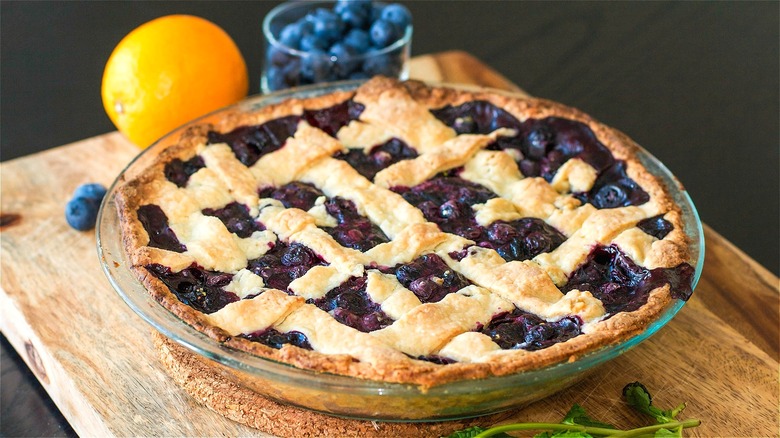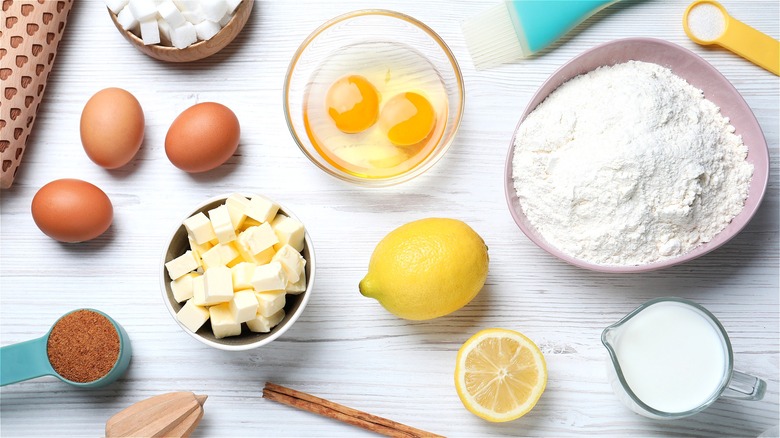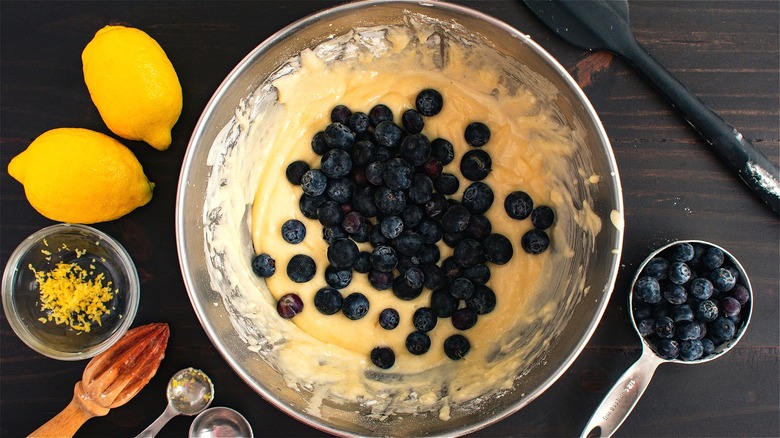What To Consider Before Adding Citrus Juice To Pie (Besides Flavor)
Next to the standard amounts of flour, butter, sugar, and salt, making a pie from scratch often calls for certain extras to enhance your dessert's signature flavor. For example, a classic lattice-top blueberry pie calls for a couple of tablespoons of lemon juice. While this acidic ingredient counteracts the sweetness of blueberries, it does add liquid to your filling. You should consider how this will impact the filling's ability to thicken properly. In many instances, a thickening agent is needed.
Beyond giving your favorite fruit or custard-based pies a flavor boost, citrus juice does alter the texture of pie filling in more ways than one. In the most basic sense, adding too much liquid to your pie's central ingredients can create a runny dessert with a soggy-bottomed crust. When berries are mixed with sugar, fruits' inner moisture begins to release due to maceration. Adding lemon juice will only make your intended filling more soupy. Even though there are specific thickeners you can use to balance out an overly runny pie, there are a few exceptions when using citrus juice as a primary ingredient.
Carefully review pie ingredients before adding citrus juice
Whether you're making classic apple pie or lemon chess pie, lemon juice has more effects besides adding flavor. When crafting a fruit pie, thickeners are often required to prevent your homemade crust from becoming too soft and soaking up added moisture. However, not all thickeners work well with the addition of lemon juice.
Corn starch is a common thickener that fails under the acidic constraints of citrus juice. This is especially problematic if you want your homemade pie to last beyond a day or two. The added cornstarch will become less effective in maintaining your filling's texture. While you might consider flour a worthwhile alternative, this standard thickener can easily dull the brightness of your pie, slightly muting the contrasting sweet and sour flavor balance.
Whichever thickener you use, you may need less depending on how your pie is prepared. Pies with a lattice top or exposed filling will need less thickeners because the liquid-based interior cooks down more effectively. You may also want to consider your filling's natural pectin. Pectin is a natural thickener found in many fruits and vegetables. Fruit pies made with apples, cranberries, and blackberries tend to have more pectin than pies made with raspberries, cherries, or plums. High-pectin fruit pies will need less thickener. If you're still worried about the addition of citrus juice altering the consistency of your pie, consider including pectin-producing citrus peel in the mix.
Effective ways to add citrus to pie without altering the texture of your dessert
Citrus fruits including the rind and peel are naturally high in pectin. Yet, how do you incorporate parts of an entire lime or lemon into your pie filling? Use a food processor or blender to pulverize a portion of whole citrus fruit, adding the crushed fruit to your prepared filling. While commercial pie thickeners aid the naturally occurring pectin in your fruit filling, pectin from the added lemon, lime, or orange solidifies your pie's interior. Don't worry about the citrus fruit overpowering the flavor of your pie. Once baked, this citrus-infused dessert has a subtle yet well-rounded flavor.
If adding a portion of an entire lemon to your next strawberry pie feels overwhelming, why not use less juice in exchange for zest? Upgrade your homemade pie crust by infusing citrus zest and a bit of juice. Since zest doesn't hold excess moisture, this convenient ingredient is easily incorporated into your pie's crust and filling. However, if you're set on using citrus juice, consider your pie's other ingredients to avoid adding too much. Otherwise, counteract this liquid addition with a commercial thickening agent other than cornstarch to balance your pie's resulting consistency.


